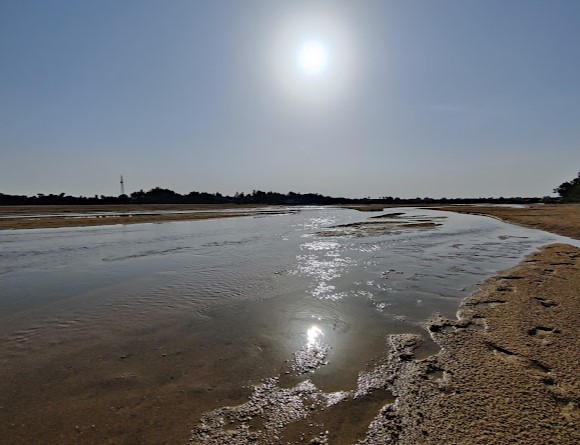- This temple is one of the 276 Devara Paadal Petra Shiva Sthalams and is the 68th Shiva Sthalam situated on the southern bank of the Cauvery River in Chozha Nadu (Thenkarai). Here, Lord Shiva is revered as a Swayambumurthi (self-manifested).
- The temple faces east and features a single corridor. Its main tower is unique in that it is not tiered; instead of a traditional Gopuram, it showcases a beautiful sculpture of Lord Shiva and Goddess Parvathy.
- However, the second entrance of the temple does have a striking three-tiered tower.
- The most recent consecration ceremony (Maha Kumbabishekam) occurred on October 22, 2015, following an earlier ceremony on February 9, 1992.
HISTORY:
- This ancient temple is located on the southern bank of the Arisilaru River. Constructed from granite by the Chola dynasty, it was later renovated by King Kulothungan III and the Nayakkars.
- Commonly known as the "Kottai Shiva Temple," it is believed that the temple was once enclosed by a large fortress, complete with tanks (Akazhi) on either side of its walls.
- Today, only the ruins of the fortress and the tanks remain.
- In his hymns, Saint Sundaramurthy Nayanar praises the splendour of this fort, its halls, and the temple itself.
- Historically, the area was home to many Sakkiyas (Buddhists), which led to the name "Sakkiya Kottai," later shortened to Sakkottai.
This temple is one of the Saptastanam temples linked to the Sri Adhi Kumbeswarar Temple in Kumbakonam. The other temples in this group are Kottaiyur, Thiru Valanchuzhi, Darasuram, Swamimalai, Kumbakonam, and Melaikkaveri.
Twelve prominent Shiva temples participate in the famous "Mahaamaham" festival, during which the "Theerthavaari" ritual takes place in the Mahaamaha tank.
This grand festival is celebrated once every 12 years in Kumbakonam.
The participating Shiva temples are:
- Kasi Viswanathar Temple, Kumbakonam
- Aadhi Kumbeswarar Temple, Kumbakonam
- Someswarar Temple, Kumbakonam
- Nageswarar (Vilvavaneswarar) Temple, Kumbakonam
- Kalahasteeswarar Temple, Kumbakonam
- Gauthameswarar (Upaveethanathar) Temple, Kumbakonam
- Koteeswarar Temple, Kottaiyur
- Amirthakalasanathar Temple, Kalayanallur
- Bhanapureeswarar Temple, Kumbakonam
- Abhimukeswarar Temple, Kumbakonam
- Aathikambatta Visvanathar Temple, Kumbakonam
- Ekambareswarar Temple, Kumbakonam
In addition, five Vaishnava temples in Kumbakonam also partake in this festival. However, their Theerthavaari takes place in the River Kaveri instead of the Mahaamaha tank.
These Vaishnava temples include:
- Sri Saarangapani Temple
- Sri Chakrapaani Temple
- Sri Ramaswami Temple
- Sri Rajagopalaswami Temple
- Sri Aadhivaraha Perumal Temple
PURANIC SIGNIFICANCE:
The Pralayam and the Amutha Kalas
According to Hindu mythology, at the end of every "yuga," a massive flood known as "Pralayam" leads to the destruction of all living beings on Earth. To preserve life, Lord Shiva, through Lord Brahma, arranged for the seeds of all organisms and the four Vedas and Puranas to be placed in a pot (Amutha Kalas or Kumbham) filled with nectar (amirtham). This pot was beautifully decorated and kept atop Mount Kailash. As the Maha Pralayam began, it destroyed all life, causing the pot to be displaced and float on the seas for years. Eventually, when the flood subsided, the pot settled in Kumbakonam, where Lord Shiva, taking the form of a hunter (Kiratha Murthy), split open the pot with his arrow, leading to the resurgence of life on Earth.
The Shivalingams
When Lord Shiva opened the pot, the decorative items fell to various places, each becoming a Shivalingam. These sites include:
- Kumbesam: This is where the Amutha Kalas remained, now known as the Sri Aadhi Kumbeswarar Temple. It is believed that Lord Kiratha Murthy fashioned a Shivalingam from the broken pot’s pieces, mixing nectar and sand. The Shivalingam is shaped like the neck of a pot (Kudamukku).
- Somesam: The location where the pot’s string (Uri/Sikkam) fell, now the Sri Someswarar Temple.
- Nagesam: The site of the fallen vilvam (leaf used in poojas), now known as the Sri Nageswarar Temple.
- Abhimugesam: The location where the coconut from the pot fell, known today as the Sri Abhimugeswarar Temple.
- Gautamesam: The site where the sacred thread fell, now the Shri Gautameswarar Temple.
- Kudavoil: This is where the rim of the pot fell, now recognized as the Sri Koneswarar Temple at Kudavasal.
- Kalayanallur (Saakkottai): The place where the mid-portion of the pot landed, known as the Sri Amirthakalasa Nathar Temple.
- Bhanathurai: The site where Lord Shiva broke the pot with his arrow, now the Sri Bhanapureeswarar Temple.
- Maalathivanam: The place where the flowers from the pot fell, now the Sri Aathikampatta Viswanathar Temple.
- Kalahastheeswarar Koil: The location where the chandan (sandalwood) from the pot fell.
- Ekambareswarar Temple: The site where other decorative items from the pot landed.
- Kottaiyur Sri Koteeswarar Temple: The location where some drops of nectar fell.
The Spread of Nectar
- The nectar from the Amutha Kalas is believed to have reached the Mahaamaham and Potraamarai tanks.
- It is said to have spread over an area of about 24 kilometres, encompassing five Shiva temples known as "Panchakurosa Sthalams" (meaning five temples).
These are:
Thiruvidaimaruthur
Koranattu Karuppur
Thirunageswaram
Swamimalai
Dharasuram
Goddess Parvathy's Penance
It is believed that Goddess Parvathy performed penance in this area, leading to a separate shrine named "Sri Thapas Amman" in the temple corridor.
Pleased with her devotion, Lord Shiva married her. Saint Sundarar refers to this legend in the first stanza of his hymn.
Worship by Saints
The temple has been revered by notable figures, including Lord Brahma, Saint Sundaramurthy Nayanar, and Saint Sakkiya Nayanar, who have all worshipped the deity here.
PEOPLE WORSHIPPED HERE:
- Another origin of the name is attributed to Saint Sakkiya Nayanar, one of the 63 Nayanmars, who worshipped here despite being a Buddhist.
- His deep devotion to Lord Shiva earned him the divine blessing of darshan from both Lord Shiva and Goddess Parvathy, ultimately leading to his recognition as one of the Nayanmars.
ADMINISTRATION:
The temple is currently managed by the Hindu Religious and Charitable Endowments Department of the Government of Tamil Nadu (HR&CE).
7ee353.jpg)

